|
Introduction to New Testament Transmission
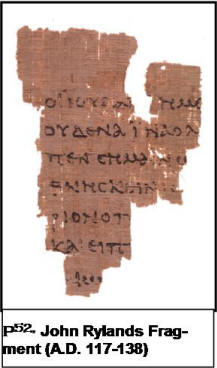
The New Testament like the Old Testament has no
surviving autographs, and relies on the transmission of
scripture over the generations. However, there are several
differences between the New and Old Testaments
regarding scripture transmission.
The period of New Testament transmission is much
shorter then the Old Testament, stretching from A.D. 50-100 to
1450’s, about 1400 years. The Old Testament range is 1800 to
2800 years (1450 B.C. to A.D. 1400’s). Additionally, there are
many more New Testament manuscripts nearer to the original
autographs, (A.D. 40-100) some dating to within 60-years. Even
though the Hebrew manuscripts are smaller in number, they tend
to be of higher quality.
The purpose of the New Testament manuscripts was to
transmit the Gospel message to the church of Jesus Christ. The
last two verses in the Gospel of John speak for much of the
Gospels and the New Testament.
24 This is the disciple who testifies of these things, and wrote
these things; and we know that his testimony is true. 25 And
there are also many other things that Jesus did, which if they
were written one by one, I suppose that even the world itself
could not contain the books that would be written. Amen. John
21:24-25
The disciple John recorded in written format his personal
witness of life of Jesus Christ for later generations. The
process to bring this forward to future generations was the
process manuscript transmission.
Late or Early date?
Critics of the Bible have attempted to assign a late date to the
New Testament manuscripts claiming, they were committed to
writing in the early third century, after a period of oral
transmission. Archeological discoveries have frustrated many of
their claims; one notable skeptic was Sir William Ramsay.
Ramsay (1850’s) regarded as one of the greatest
archaeologist ever was a skeptic of the early dates attributed
to the books of the bible. He dated Acts and Luke to the mid
2nd century. After doing a topographical study of Asia Minor
and using the writings of Luke, he was forced to change his
mind. He wrote,
“I
found myself brought into contact with the “Book of Acts” as an
authority for the topography, antiquities and society of Asia
Minor. It was gradually borne upon me that in various details
the narrative showed marvelous truth”.
The intricate details in the New Testament, including people,
places and geographic markers, make a late date a virtual
impossibility.
In addition to Archeological evidence, manuscript
evidence also point to an early date. The John Rylands Fragment
(P52), which is dated between
A.D. 117-138, makes late date for the Gospel of John seem rather
silly. Manuscripts such as the Chester Beatty Papyri (P52, P46,
P47) (A.D. 250) and the Bodmer Papyri (P66, P72, P75) (A.D.
200) cement an early date to the New Testament books, with the
latest book being Revelation revealed during the reign of
Domitian (A.D. 81-96).
Oral or Written transmission?
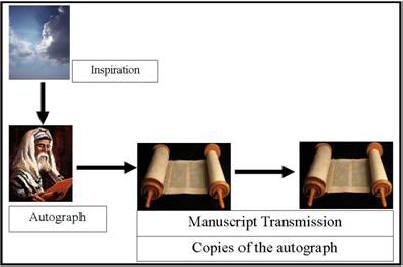 The
transmission of the Gospels, Epistles and the rest of the New
Testament was not an oral transmission but a written
transmission. The book of Revelation, the last book of the New
Testament was a written letter to the seven-churches in Asia.
John is specifically told to write down, what he sees and send
it to the seven-churches, meaning the scripture is God-breathed
or “inspired”. The
transmission of the Gospels, Epistles and the rest of the New
Testament was not an oral transmission but a written
transmission. The book of Revelation, the last book of the New
Testament was a written letter to the seven-churches in Asia.
John is specifically told to write down, what he sees and send
it to the seven-churches, meaning the scripture is God-breathed
or “inspired”.
11 saying, "I am the Alpha and the Omega, the First and the
Last," and, "What you see, write in a book and send it to the
seven churches which are in Asia: to Ephesus, to Smyrna, to
Pergamos, to Thyatira, to Sardis, to Philadelphia, and to
Laodicea." Revelation 1:11
Luke
like John wrote under the inspiration of the Holy Spirit,
with the purpose of documenting the events in a written format
for future generations.
1 Inasmuch as many have taken in hand to set in order a
narrative of those things which have been fulfilled among us, 2
just as those who from the beginning were eyewitnesses and
ministers of the word delivered them to us, 3 it seemed good to
me also, having had perfect understanding of all things from the
very first, to write to you an orderly account, most excellent
Theophilus
Luke 1:1-3
At the point, when the
scripture was committed to paper, the witness of the apostles
was apostolic witness of past events, was not the result of
human effort, but inspiration from the Holy Spirit.
26 "But the Helper, the Holy Spirit, whom the Father will send
in My name, He will teach you all things, and bring to your
remembrance all things that I said to you.John 14:26
How was scripture written?
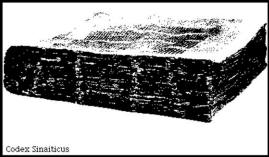 From
the time of Moses, to the close of the Old Testament, the method
of writing varied in the land of Israel. The more permanent
form being words recorded in stone, clay and metal, which could
last thousands of years. Stone and clay was limited in mobility
and content, only so much could be written on a stone, and the
material written, eventually the weight limited its ease of use. From
the time of Moses, to the close of the Old Testament, the method
of writing varied in the land of Israel. The more permanent
form being words recorded in stone, clay and metal, which could
last thousands of years. Stone and clay was limited in mobility
and content, only so much could be written on a stone, and the
material written, eventually the weight limited its ease of use.
Leather and Papyrus followed clay and stone, Leather
lasted longer then Papyrus but cost more, both were easier to
use, but less permanent then stone and clay. The Dead Scrolls
contained scrolls written on leather, Papyrus and copper,
demonstrating living recorded of how documents were prepared and
transmitted in the first century.
The New Testament manuscripts, transmitted on
papyrus and leather scrolls initially, with papyrus being the
more likely alternative. The earliest surviving New Testament
manuscripts are made of papyrus.
During the 2nd century, the technology of
writing advanced with the development of the Codex versus
the scroll. The codex was the early form of the book, which
solved many problems with ease of use. Papyrus sheets were
stacked upon each other and stitched down the center, with
writing on both sides. The earliest manuscript (P52) has
writing on both sides, which suggest it was an early Codex
manuscript.
In addition to Papyrus scroll and codex, parchment,
other materials were also used to transmit the scriptures.
|
|
Other materials which scripture was
transmitted |
|
1 |
Vellum: animal skins from
lambs and young goats, which was rather costly, finer
then parchment and more costly, the materials was soaked
in lime, giving it a white sheen, which allowed a
cleaner and then regular animals skins. Velum was
sometimes obtained from animals not yet born. |
|
2 |
Parchment: The name is derivived
from the city of Pergamum in Asia Minor, which was a
major manufacturer of the material. The material was
used by the 2nd century B.C. for scripture,
as the Dead Sea scrolls demonstrated. Like Vellum,
parchment was soaked in lime to give it whitish clear
look. |
|
3 |
Redressed parchment: After the
original writing became faded, the parchment could be
used again after the original writing was erased. These
became known as palimpsest (Greek, “rubbed
again”) rescriptus (Latin, “rewritten”). Codex
Ephraemi Rescriptus ( C ) is an example of this type of
manuscript. |
|
4 |
Paper:
Invented in China in
second century A.D, it was manufactured in Arabia in the
eighth century, introduced into Europe in the 10th
century, manufactured in Europe in the 12th
century, and became common by the 13th
century. |
Manuscript
types
There are four main manuscript types for the New
Testament documents. These four types of
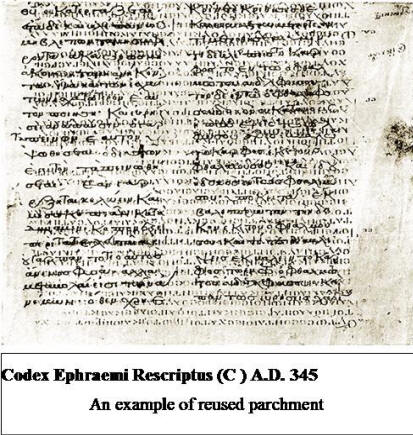 manuscripts
are used to classify the 5,336 (5222)
New Testament manuscripts, which are known to exist. These four
types are, Papyri MMS, ( P1-88) Unical MSS (01-274),
Minuscules MSS (01-2795)and Lectionaries (01-2209). manuscripts
are used to classify the 5,336 (5222)
New Testament manuscripts, which are known to exist. These four
types are, Papyri MMS, ( P1-88) Unical MSS (01-274),
Minuscules MSS (01-2795)and Lectionaries (01-2209).
Papyri MMS (P 1-88) ) (2nd-3rd
century)
The earliest Greek NT manuscripts are Papyri manuscripts, all
including the earliest one (P-52) are from a codex format. The
manuscripts number 88, and are delineated by a letter P followed
by the manuscript number. John Rylands Fragment is P 52.
Uncial MSS (4th- 9th century)
These manuscripts number about 274; they are some of
the most important, if not the most important manuscripts of the
New Testament. They include Codex’s, Sinaticus,
Vaticanus and Alexandrinus among others. These
manuscripts appeared after Constantine authorized the making of
multiple copies of scripture after the council of Nicea A.D.
325.
They utilize Greek capital letters with curves so
they could be written on the common writing materials. There
are no breaks between words or sentences and no punctuation
marks, these manuscripts utilize a style known as scripta
continua (“continuous script”).
These manuscripts are identified by a capital
letter, mainly Latin letters, also Hebrew and Greek. Codex
Sinaiticus is identified by the Hebrew letter aleph (
a)),
Codex Vaticanus by the letter ( B) and Codex Alexandrinus by the
letter (A).
About one in five Uncials are palimpsest
manuscripts, which are reused parchments. When the scripture
text became worn, it was erased and used for another purpose.
Some of the early texts have been recovered, which lie
underneath a later writing. One example is the Ephraemi
manuscript dated to A.D. 345, of the New Testament was written
over by in the twelfth century and replaced by the 38 sermons of
a 4th century Syrian church father Ephraem.
Minuscules MSS (9th-15th century)
Following the Uncial type of manuscript was the Minuscule, which
used a smaller cursive script developed at the close of the
ninth century. These manuscripts number 2,745, about eight
times the number of Uncials manuscripts. They were written from
the 8th to the 15th century. The earliest
Minuscule manuscript is dated to the year A.D. 835 and contains
the four Gospels, located in Leningrad State Public Library.
Lectionaries MSS
The church developed a lectionary, so both Old and New
Testaments could be read over the course of a year.
Lectionaries was the scripture reading in the church, they also
stand as a witness to the scripture, but in a secondary nature.
They number about 2,209, Lectionaries are hard to date, since
they were used throughout Church history, and they still used
the Uncial writing long after the Minuscule had taken over.
Regarding their value, Geisler writes,
It must be admitted, however, that lectionaries are only of a
secondary value in establishing the New Testament text. (1.)
They contain all the New Testament many times over, with the
exceptions of Revelation and parts of Acts. (2) As a result of
recent scholarship on the lectionaries, they are assuming a more
significant role in establishing the true text. Lectionary text
types are predominantly Byzantine, but there are certain groups
that are characterized b Alexandrian and Caesarean readings.
Are the New Testament Manuscripts reliable?
The large number of Greek manuscripts often leads to
the question, how reliable is the New Testament? When we
compare the Greek manuscripts for the New Testament to other
ancient books, and their manuscript witness nothing even comes
close to what the New Testament offers. The Greek historian
Herodotus, whose is called the father of history, wrote in the 5th
century B.C., the earliest surviving work is almost 1000-years
after his lifetime, with only eight known manuscripts existing.
Compare this to the NT, with over 5000 manuscripts.
Secondly, the time between the autograph and the
manuscript copy is extremely short when we compare the New
Testament to other works, which are not even questioned as to
their authenticity. Caesar’s war commentary on the Gallic
Wars, which is dated to 44 B.C., has only 9 to 10 existing
manuscripts surviving. The earliest manuscript is almost
1000-years after the events. Compare this to the New Testament,
which has some manuscripts dated to 60-years or earlier to the
actual autograph, and copies of the each book of the NT, dated
less then 200-years from the autograph. In addition, we have
entire New Testaments, written 300-years from the NT period.
Sir Frederic Kenyon writes about the reliability of
the scriptures,
The interval then between the dates of the original composition
and the earliest extant evidence becomes so small as to be in
fact negligible, and the last foundation for any doubt that the
Scriptures have come down to us substantially as they were
written has now been removed. Both the authenticity and the
general integrity of the books of the New Testament may be
regarded as finally established.
|
Author |
Book |
Date Written |
Earliest Copies |
Time Gap |
No. of Copies |
|
Homer |
Iliad |
800 BC |
C. 400 BC |
400 years |
643 |
|
Herodotus |
History |
480-425 BC |
C. 900 AD |
1350 years |
8 |
|
Thucydides |
History |
460-400 BC |
900 AD |
1300 years |
8 |
|
Plato |
|
400 BC |
900 AD |
1300 years |
8 |
|
Demosthenes |
|
300 BC |
900 AD |
1300 years |
7 |
|
Caesar |
Gallic Wars |
100-44 BC |
900 AD |
1000 years |
10 |
|
Livy |
History of Rome |
59-17 AD |
4th Century (Partial), Mostly 10th
Century |
400 years
1000 years |
1 partial
19 copies |
|
Tacitus |
Annals |
100 AD |
1100 AD |
1000 years |
20 |
|
Pliny Secundus |
Natural History |
61-113 AD |
850 AD |
750 years |
7 |
|
New Testament |
|
50-100 AD |
114 Fragments 200 (Books) 250 (Most NT) 325
(Complete NT) |
50 years 100 years 150 years 225 years |
5366 |
The Early Church fathers
Another witness to
scriptures are the writings of the early church fathers, who
wrote in the early church period and centuries following. They
quote some 36,289 references to the New Testament. If we lost
all the manuscripts, we could reconstruct the New Testament from
their citations alone.
|
Writer |
Gospels |
Acts |
Pauline Epistles |
General Epistles |
Revelation |
Totals |
|
Justin Martyr
(133 AD) |
268 |
10 |
43 |
6 |
3 (266 allusions) |
330 |
|
Irenaeus
(180 AD) |
1038 |
194 |
499 |
23 |
65 |
1819 |
|
Clement
(150-212 AD) |
1107 |
44 |
1127 |
207 |
11 |
2406 |
|
Origen
(185-253 AD) |
9231 |
349 |
7778 |
399 |
165 |
17,992 |
|
Tertullian
(166-220 AD) |
3822 |
502 |
2609 |
120 |
205 |
7258 |
|
Hippolytus
(170-235 AD) |
734 |
42 |
387 |
27 |
188 |
1378 |
|
Eusebius
(324 AD) |
3258 |
211 |
1592 |
88 |
27 |
5176 |
|
Grand Total |
19,368 |
1352 |
14,035 |
870 |
664 |
36,289 |
Text Families
When the churched spread throughout the Greek,
Roman, Asian and African world, the New
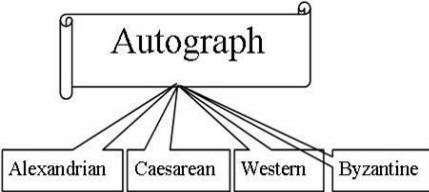 Testament
manuscripts also went with it. Because of great distances,
regional between various parts of the Christian world, centers
of influence were established. From these centers flowed
manuscript copies to be used by individuals and churches. These
centers of influence are known as text types, since the
manuscript can be traced to a geographic area, which it was
copied. The manuscript families are; 1. Alexandrian 2.
Caesarian 3. “Western” 4.Byzantine. Testament
manuscripts also went with it. Because of great distances,
regional between various parts of the Christian world, centers
of influence were established. From these centers flowed
manuscript copies to be used by individuals and churches. These
centers of influence are known as text types, since the
manuscript can be traced to a geographic area, which it was
copied. The manuscript families are; 1. Alexandrian 2.
Caesarian 3. “Western” 4.Byzantine.
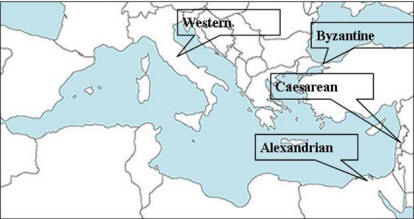 When
a manuscript has a combination of text from different text
families, it is known as a mixed manuscript. When
a manuscript has a combination of text from different text
families, it is known as a mixed manuscript.
The differences between the text type is minimal and
has no effect on doctrinal issues in the church. In our attempt
to find, the best reading of the New Testament, closest to the
original, autograph, we need to examine the available
manuscripts, and their text families.
Regarding the variation between copies from the
“text families”, Paul Wegner puts this in perspective,
It is important near the beginning of our discussion on New
Testament textual criticism to note that the verbal agreement
between various New Testament manuscripts is closer than between
many English translations of the New Testament and that the
actual number of variants is small (approximately 10%), none of
which call into question any major doctrine.
The greatest number of variants are differences or errors in
spelling. For example, the author of Codex Vaticanus spells
“John” with only one n instead of the common spelling with two.
This type of variant makes no difference in the meaning of the
text.
The second largest group of variants arises because of
omissions of small Greek words or variations in word order. For
example, in Greek a person’s name may or may not be preceded in
an article(“the”). And the phrase the good man could also be
written in Greek as “the man, the good one,” although in English
both phrases are translated as “the good man”. These types of
variants also make no difference in the meaning of the text.
It is very rare for a scribe to accidentally make nonsense
out of a word or phrase when copying, but it does happen. One
scribe accidentally wrote the Greek letter pi instead of phi in
Luke 6:41, rendering the text, “Why do you look at the fruit in
your brothers eye” instead of “Why do you look at the speck in
your brothers eye.” These types of errors are easily
identifiable.
Textual Criticism of the New Testament
The purpose of textual criticism is to come as close
as possible to the original autograph, by examining the
available and manuscripts and their texts. We must however
distinguish this from “Higher criticism”. Textual criticism does
not question the inspiration of scripture, but is concerned with
the text of the Bible, attempting to restore the autograph, from
the available manuscripts.
Jerome the translator of the Latin Vulgate (A.D.
382-390) was an early textual critic of the New Testament. To
prepare his translation, he needed to compare various
manuscripts to determine the most accurate reading, which to use
as the source for his translation. Jerome’s translation was the
dominant Latin translation in Europe for almost 1000-years.
The current debate in many churches has its roots in
the source manuscript used in the translation. In the 14th
century, the availability of Greek manuscripts was not like
today. The King James Bible, used a Greek text, commonly known
as the Textus Receptus
or Received Text.
The forth edition of the Textus Receptus was used as
the New Testament Greek source for both the King James Bible
(1611) and the Geneva Bible (1557 and 1560). This version used
15-Greek manuscripts giving variant readings in the margins.
The verse divisions of the Textus Receptus was also adopted in
the King James translation.
|




 From
the time of Moses, to the close of the Old Testament, the method
of writing varied in the land of Israel. The more permanent
form being words recorded in stone, clay and metal, which could
last thousands of years. Stone and clay was limited in mobility
and content, only so much could be written on a stone, and the
material written, eventually the weight limited its ease of use.
From
the time of Moses, to the close of the Old Testament, the method
of writing varied in the land of Israel. The more permanent
form being words recorded in stone, clay and metal, which could
last thousands of years. Stone and clay was limited in mobility
and content, only so much could be written on a stone, and the
material written, eventually the weight limited its ease of use. manuscripts
are used to classify the 5,336 (5222)
manuscripts
are used to classify the 5,336 (5222) Testament
manuscripts also went with it. Because of great distances,
regional between various parts of the Christian world, centers
of influence were established. From these centers flowed
manuscript copies to be used by individuals and churches. These
centers of influence are known as text types, since the
manuscript can be traced to a geographic area, which it was
copied. The manuscript families are; 1. Alexandrian 2.
Caesarian 3. “Western” 4.Byzantine.
Testament
manuscripts also went with it. Because of great distances,
regional between various parts of the Christian world, centers
of influence were established. From these centers flowed
manuscript copies to be used by individuals and churches. These
centers of influence are known as text types, since the
manuscript can be traced to a geographic area, which it was
copied. The manuscript families are; 1. Alexandrian 2.
Caesarian 3. “Western” 4.Byzantine.  When
a manuscript has a combination of text from different text
families, it is known as a mixed manuscript.
When
a manuscript has a combination of text from different text
families, it is known as a mixed manuscript.